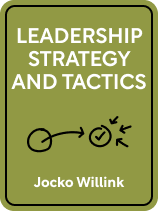

This article is an excerpt from the Shortform book guide to "Leadership Strategy and Tactics" by Jocko Willink. Shortform has the world's best summaries and analyses of books you should be reading.
Like this article? Sign up for a free trial here.
What is balanced leadership? Why is it important? How can you create a balanced leadership style?
In Leadership Strategy and Tactics, Jocko Willink presents over 30 pieces of leadership guidance, primarily based on leading with humility and creating a balanced leadership style. According to him, striking a balance helps you lead your team most effectively.
Read on to learn more about balanced leadership, according to Willink.
Good Leaders Are Balanced
If you want to be a good leader, you have to put your team before yourself. Jocko Willink explains exactly how to do this in Leadership Strategy and Tactics. According to him, by learning to practice humility, build good relationships, and take responsibility for your team’s mistakes, you’ll elevate your team to success and empower them to become leaders themselves. Willink is an author, speaker, and podcaster who served for 20 years as a U.S. Navy SEAL. He argues that leaders must remain balanced to operate effectively. He claims that the extreme ends of any strategy or behavior can be harmful. In this article, we’ll focus on Willink’s definition of leadership and how to create a balanced leadership style.
What Is Leadership?
According to Willink, leadership is the ability to get people to support each other to achieve a common goal. He explains that leadership fundamentally involves getting people to do what you want them to do—when what you want them to do serves the common interest. Although this sounds similar to manipulation, Willink claims that these two strategies have different purposes. If you’re manipulating people, you’re simply controlling others to serve your own benefit. Manipulation might secure temporary success, but your team will eventually recognize your self-interested motivation and stop following you.
In contrast, Willink claims true leadership is motivated by the good of the people you’re leading and a goal you all share. If you lead to benefit your team and achieve a common mission, your team will recognize this and follow you.
Balance Between Optimism and Realism
When your team is facing difficulty and morale is low, maintain a balanced attitude in your leadership. Your attitude as a leader influences the attitudes of the people on your team. If you succumb to negativity, your team will follow suit. On the opposite end, if you’re blinded by optimism and put an unrealistically positive spin on everything, your team will think you’re oblivious to the problems at hand. As a result, you’ll lose credibility with your team. Instead, acknowledge the reality of the situation but focus your effort on the solution.
(Shortform note: In The Obstacle Is the Way, Ryan Holiday explains that according to Stoicism, no situation is inherently good or bad. Rather, your perspective determines whether something is good or bad. So, in the face of adversity, Stoic philosophy says you should view challenging situations as opportunities for some kind of good. Holiday argues that this perspective will prime you to discover hidden solutions in your problems and overcome them.)
Balance Between Praise and Criticism
In a balanced leadership style, it’s important to be complimentary, but give your team a goal to strive for, when giving feedback. If you give purely complimentary praise, you might make your team arrogant and complacent. And if your team gets complacent, they won’t perform as well as they could. On the other hand, if you dish out nothing but criticism, your team might lose motivation. Constant criticism without praise can lead your team to think they don’t need to perform at their best because their efforts aren’t appreciated anyway. So, give your team praise, but encourage continuous improvement.
(Shortform note: In Principles: Life and Work, Ray Dalio lists several ways to keep feedback fair and effective in balanced leadership. When you’re delivering negative feedback, you should be honest and specific about how they can improve. Support your points with data and don’t sugarcoat what you have to say. To prevent the recipient of your feedback from worrying unnecessarily about small, negative points, cushion your criticisms by putting them in the context of their total performance. Another way to balance your approach to feedback is to adapt your review to the individual you’re speaking to. One person might be sensitive, while another person is combative. Adjust accordingly.)
What About Taking Responsibility?
Willink coined the phrase “extreme ownership” and even titled a book after it. In this section, we’ll explore what this means, referring to it as “radical responsibility.” In contrast to Willink’s idea of balanced leadership, radical responsibility means taking responsibility for all of the problems related to your team and mission. A mindset of radical responsibility not only puts you in a position to solve whatever problems are at hand, but it also helps prevent future issues. If you know that you’ll bear the weight of responsibility for any of your team’s potential missteps, you’ll take preemptive actions to avoid mistakes.
| Can Radical Responsibility Lead to Burnout? In The Road Less Traveled, M. Scott Peck agrees with Willink that taking responsibility for problems leads to active solutions. However, he explains that an excessive sense of responsibility—believing everything is your fault—is an expression of neurotic behavior. This can lead to anxiety, fear of commitment, and a lower quality of life. To maintain a positive, action-oriented mindset, The Subtle Art of Not Giving a F*ck says to distinguish fault from responsibility. Fault concerns the uncontrollable past, but responsibility concerns the present—which you have the power to influence. For example, you’re not at fault for a critical mistake your team member made yesterday, but you’re responsible for your reaction to that problem today. |
Another benefit of taking responsibility is that it’s contagious. By taking responsibility for a problem, you’ll inspire other people to take responsibility, too.
(Shortform note: Although taking responsibility sets an inspiring example for your team to follow, you might not always be around to set the tone. The authors of Built to Last argue that you should encourage your team to align themselves not with you as a leader, but with the values of your culture—in this case, the cultural value would be radical responsibility. The most important leadership quality that sets long-lasting companies apart is a long-term vision and concern for organizational culture.)

———End of Preview———
Like what you just read? Read the rest of the world's best book summary and analysis of Jocko Willink's "Leadership Strategy and Tactics" at Shortform.
Here's what you'll find in our full Leadership Strategy and Tactics summary:
- A former US Navy SEAL's advice on how to be a good leader
- Three ways you can practice humility and earn your team’s respect
- Why you must always tell the truth, even when it's harsh






